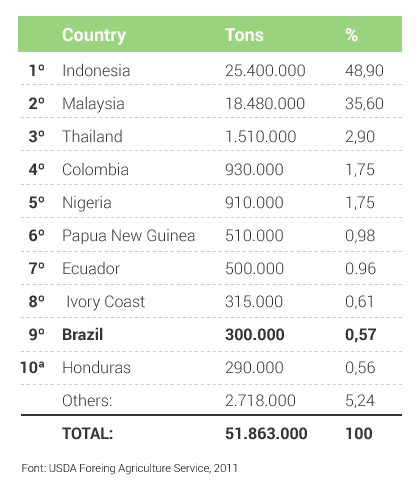Specialists estimate that the worldwide production of palm oil will reach about 58 million tons in 2014. Globally, the culture occupies 8% of the lands allocated for the growing of oleaginous. Palm provides almost a third of the global production of vegetable oils.
Malaysia and Indonesia are responsible for 85% of the worldwide production. Nigeria, Thailand, Colombia, Ecuador and Papua New Guinea represent, together, 6,6% of the production. The 8,4% that remains is divided among 36 other countries, including Brazil – which is far from being considered a great producer of palm oil.
Biggest producers of palm oil in the world:

Brazil produces about 370 thousand tons of palm oil. The biggest part comes from the territory of Pará. However, the national production cannot supply the internal demand that nowadays is, approximately, 500 thousand tons per year, which means that the country imports the product instead of producing it in degraded areas, which would help to improve the balance of emission of greenhouse gases in Amazonian agriculture.
Besides, palm is the oleaginous with most productive economic value that is known of. Its average productive is of 4 tons of oil per hectare/tear, ten times more than soy oil, for instance. In other words, it is more competitive in the global market than similar products.
See some advantages of palm:
- Produces up to 10 times more than other oleaginous;
- It is well oriented, follows the social and environmental criteria required by the Brazilian legislation and by the modern international criteria of sustainability. As a result, palm oil culture could play an important role in the reduction of poverty in producing regions;
- In Brazil, it can only be planted in degraded areas, which cannot have any other utilization;
- It can help in the abduction of carbon, contributing to mitigate the problems related to climate changes.
